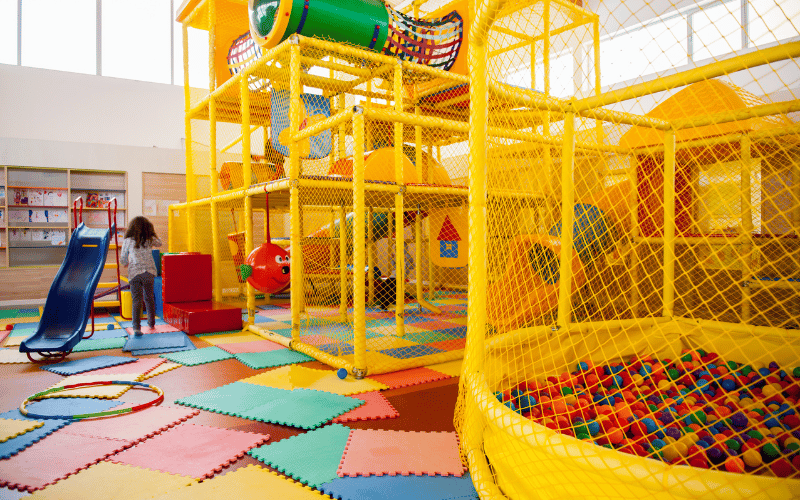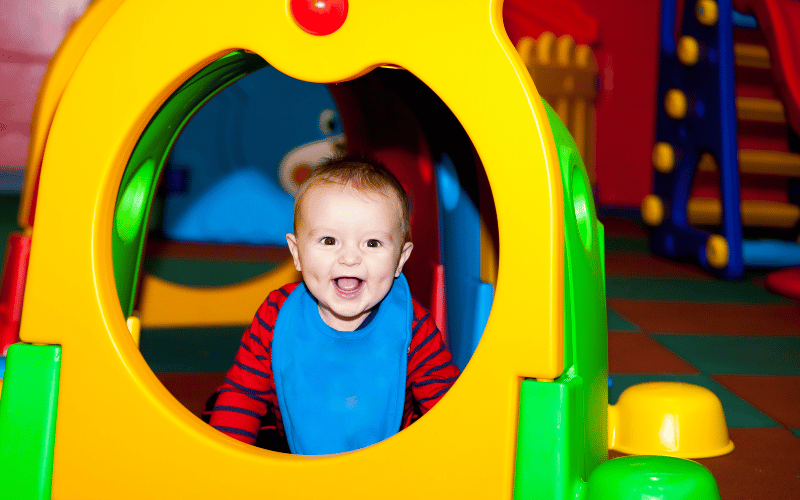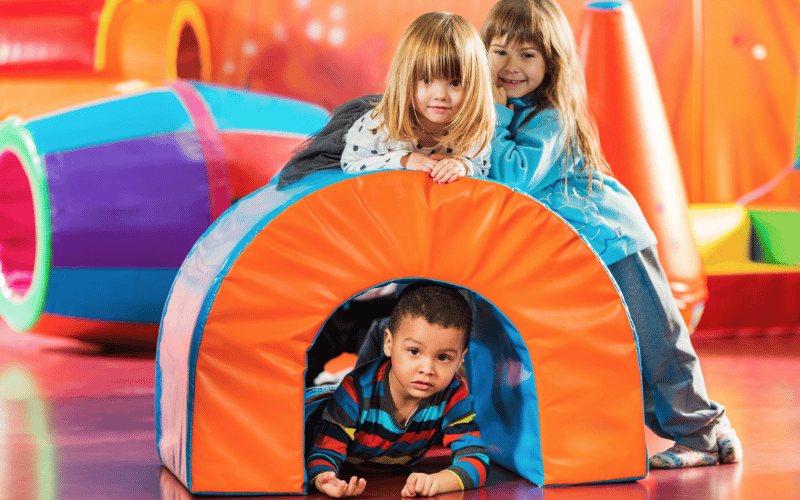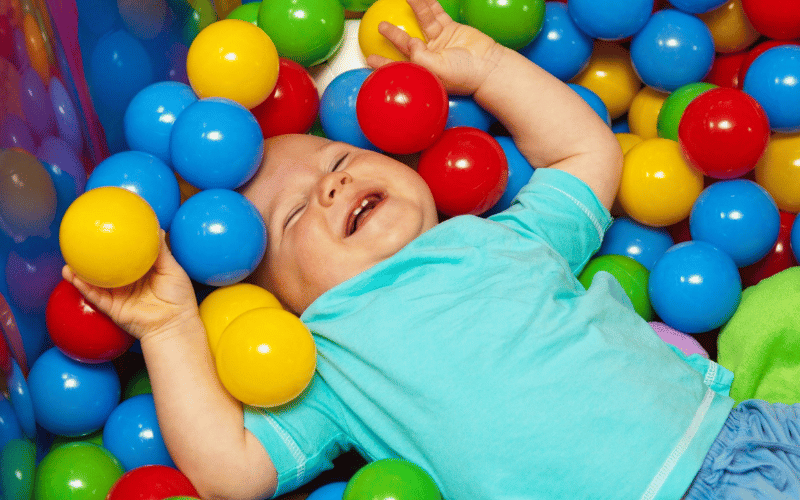Infant indoor playgrounds are dedicated areas for children aged 0 to 3 years to stimulate their sensory experiences and motor skills through gentle, thematic activities, soft play structures, and interactive sensory experiences. Constructive play enables children to explore and learn, attending to their innate curiosity. It provides children with the opportunity to learn while playing. These playgrounds and centers are progressively found in shopping malls, daycare centers, and dedicated family entertainment outlets.
Proper budgeting and planning for a project require a thorough understanding of the various budgeting components. Estimating expenses involves considering factors such as location, equipment, safety zones, and permits, which significantly impact the projected financial outlook and the project’s launch.
Table of Contents
ToggleAverage Startup Costs
Starting an indoor infant playground business typically requires an estimated investment of $133,500 to $283,000, depending on factors such as location, equipment quality, and customization. This range accounts for basic-grade equipment and essential costs like rent, safety surfacing, and labor.
For businesses that include custom-themed structures, tactile sensory panels, or are located in urban areas with higher rental rates, the investment will trend toward the higher end of the range. Proper planning and attention to safety and equipment can help balance costs while ensuring a safe and engaging environment for infants and families.
Key Cost Factors
Rent or Lease
Rent or lease costs often represent a significant portion of the budget for an indoor infant playground. Small spaces suitable for these playgrounds typically range from 500 to 2,000 square feet, with rental prices varying based on location. Urban areas with high demand for family-friendly facilities tend to have higher rental rates, often exceeding $30 per square foot annually. For example, a 1,000-square-foot space in a prime city location could cost $30,000 or more per year, while suburban or less competitive areas may offer more affordable options. Choosing a location with good visibility and accessibility can justify higher rent by attracting more visitors and increasing revenue potential.
Equipment and Installation
Age-appropriate equipment forms the heart of an infant playground, and its cost depends on the quality, variety, and customization of the features. Soft play areas, sensory panels, and padded climbing structures are essential for creating a safe and engaging environment for infants. Basic setups with standard equipment may cost around $20,000, while custom-themed designs or advanced interactive features can push the budget to $100,000 or more. Installation costs also add to the total, as professional installers ensure the equipment meets safety standards and functions properly. Investing in durable, high-quality materials reduces long-term maintenance expenses and enhances the overall experience for families.
Safety Surfacing
Safety surfacing plays a critical role in protecting infants from injuries during play. Options like padded flooring, rubber tiles, or foam mats provide cushioning and reduce the impact of falls. The cost of safety surfacing typically ranges from $5 to $15 per square foot, depending on the material and installation requirements. For a 1,000-square-foot playground, this could amount to $5,000 to $15,000. While safety surfacing adds to the upfront costs, it ensures compliance with safety regulations and builds trust with parents, making it a worthwhile investment.
Labor Costs
Hiring and training staff with expertise in infant care is essential for running a successful indoor playground. Labor costs include salaries, benefits, and ongoing training to ensure staff members can provide a safe and nurturing environment. Depending on the location and experience level, salaries for childcare professionals may range from $12 to $20 per hour. For a small playground operating with a team of three to five employees, monthly labor expenses could total $6,000 to $10,000. Investing in well-trained staff not only enhances the quality of care but also improves customer satisfaction and retention.
Insurance and Permits
Liability insurance and permits are non-negotiable expenses for any indoor playground. Liability insurance protects the business from potential claims related to injuries or accidents, with annual premiums typically ranging from $1,000 to $5,000, depending on the coverage and location. Additionally, obtaining permits to comply with local safety and zoning regulations may involve fees ranging from a few hundred to several thousand dollars. These costs ensure the playground operates legally and safely, providing peace of mind for both the business owner and the families who visit.
By carefully managing these key cost factors—rent, equipment, safety surfacing, labor, and insurance—you can create a safe, engaging, and financially sustainable indoor playground for infants.
Marketing and Advertising
To attract families and raise awareness, effective marketing and advertising efforts are crucial. A budget of $5,000 to $10,000 for initial campaigns, including social media ads, local promotions, and signage, would help establish the playground’s presence in the community.
Total Estimated Costs
- Rent or Lease:
- For a 1,000-square-foot space at $30 per square foot annually:
- $30,000
- Equipment and Installation:
- Basic setup: $20,000
- Custom-themed or advanced setup: $100,000
- Safety Surfacing:
- For a 1,000-square-foot playground at $5–$15 per square foot:
- $5,000–$15,000
- Labor Costs:
- Monthly labor costs for 3–5 employees at $6,000–$10,000:
- Annual labor costs = $6,000 × 12 to $10,000 × 12
- $72,000–$120,000
- Insurance and Permits:
- Annual liability insurance and permits:
- $1,000–$5,000 (insurance) + $500–$3,000 (permits)
- $1,500–$8,000
- Marketing and Advertising:
- Initial campaigns:
- $5,000–$10,000
Total Startup Costs:
- Minimum Total:$30,000 (Rent) + $20,000 (Equipment) + $5,000 (Safety Surfacing) + $72,000 (Labor) + $1,500 (Insurance and Permits) + $5,000 (Marketing) = $133,500
- Maximum Total:$30,000 (Rent) + $100,000 (Equipment) + $15,000 (Safety Surfacing) + $120,000 (Labor) + $8,000 (Insurance and Permits) + $10,000 (Marketing) = $283,000
Final Range:
$133,500–$283,000
Tips for Reducing Costs
Source Second-Hand or Refurbished Equipment
One of the most effective ways to lower startup costs is by purchasing second-hand or refurbished playground equipment. Many businesses sell gently used play structures, sensory panels, and soft play items at a fraction of the cost of new equipment. For example, a refurbished climbing frame or slide can cost 30-50% less than a brand-new one while still meeting safety standards. When sourcing second-hand items, inspect them thoroughly for wear and tear, and ensure they comply with current safety regulations. This approach allows you to create a functional and engaging play area without overspending.
Start with a Smaller Space
Opting for a smaller space can significantly reduce both rent and operational costs. For instance, instead of leasing a 1,000-square-foot facility, consider starting with a 500-700 square foot area. This size still accommodates essential play features like soft zones, sensory panels, and seating for parents while keeping rental expenses manageable. A smaller space also requires less equipment and fewer staff members, further lowering initial and ongoing costs. As your business grows, you can expand to a larger location or add additional features.
Focus on Multi-Functional Equipment
Investing in multi-functional equipment helps you maximize value while minimizing expenses. For example, a single play structure that combines a slide, climbing wall, and sensory activities eliminates the need to purchase separate pieces. Modular designs also allow you to adapt the equipment over time, adding new features as your budget permits. By prioritizing versatile equipment, you can create a dynamic play environment without overspending on individual items.
Use Cost-Effective Safety Surfacing
While safety surfacing is essential, you can reduce costs by choosing budget-friendly materials like foam mats or interlocking rubber tiles. These options provide adequate cushioning and meet safety standards without the higher price tag of custom flooring. For example, foam mats can cost as little as $5 per square foot, making them an affordable choice for smaller spaces. Additionally, consider sourcing surplus or discounted materials from suppliers to further cut costs.
Minimize Initial Marketing Expenses
Instead of investing heavily in traditional advertising, focus on cost-effective marketing strategies to promote your playground. Use social media platforms to reach local families, create engaging posts, and run targeted ads with small budgets. Partnering with nearby businesses, such as daycares or family-friendly restaurants, can also help you attract customers through cross-promotions. Hosting a low-cost grand opening event or offering limited-time discounts can generate buzz without requiring a large marketing budget.
Hire Part-Time or Flexible Staff
To reduce labor costs, start with a small team of part-time employees or flexible staff members. For example, hiring two to three part-time workers instead of full-time staff can save thousands of dollars in wages and benefits. Additionally, consider handling some administrative tasks yourself during the initial stages to further cut expenses. As your business grows, you can gradually expand your team to meet increasing demand.
By implementing these cost-saving strategies—sourcing second-hand equipment, starting with a smaller space, and focusing on multi-functional designs—you can launch a successful indoor playground while keeping expenses under control.
Benefits of Indoor Infant Playgrounds
Provides a Safe and Engaging Environment for Infants
Indoor infant playgrounds create a controlled and secure space where young children can explore, play, and develop essential skills. Unlike outdoor playgrounds, these indoor facilities shield infants from harsh weather conditions, extreme temperatures, and environmental hazards. Soft play equipment, padded flooring, and age-appropriate features minimize the risk of injuries, allowing infants to crawl, climb, and interact freely. For example, sensory panels with tactile elements or soft climbing structures encourage the development of motor skills and cognitive growth in a safe setting. This focus on safety and engagement ensures that infants can enjoy enriching play experiences without unnecessary risks.
Offers Convenience for Parents
Indoor playgrounds provide a convenient solution for parents seeking a reliable and accessible space for their children to play. Located in shopping malls, community centers, or standalone facilities, these playgrounds typically operate year-round, providing families with a consistent option regardless of weather conditions. Parents can relax in designated seating areas while keeping an eye on their children, or they can use the time to socialize with other caregivers. Many facilities also offer amenities such as diaper-changing stations, snack bars, and Wi-Fi, further enhancing the overall convenience for families. This combination of accessibility and thoughtful amenities makes indoor playgrounds a preferred choice for busy parents.
Encourages Social Interaction and Development
Indoor infant playgrounds foster social interaction among children and parents, creating opportunities for community building. Infants benefit from playing alongside peers, which helps them develop social skills like sharing, cooperation, and communication. For instance, a shared sensory activity or group play session can encourage infants to engage with others in a positive and supportive environment. Parents also have the chance to connect with other caregivers, share experiences, and build relationships, strengthening the sense of community. These interactions contribute to the emotional and social well-being of both children and their families.
Promotes Physical and Cognitive Development
The design of indoor infant playgrounds supports both physical and cognitive growth. Features such as soft climbing structures, tunnels, and balance beams help infants develop their gross motor skills, coordination, and strength. At the same time, sensory panels, interactive games, and colorful designs stimulate cognitive development by encouraging problem-solving, exploration, and creativity. For example, a sensory wall with spinning gears or textured surfaces can captivate an infant’s attention while promoting fine motor skills and curiosity. By combining physical and mental stimulation, these playgrounds provide a holistic approach to early childhood development.
Creates a Weather-Independent Play Option
Indoor playgrounds eliminate the limitations imposed by weather, ensuring that families have a reliable play option throughout the year. Rain, snow, or extreme heat often restrict outdoor activities, leaving parents searching for alternatives. Indoor facilities address this issue by providing a climate-controlled environment where children can play comfortably, regardless of the season. This consistency enables families to maintain regular play routines, which are crucial for a child’s development and overall well-being.
By providing a safe, engaging, and convenient space for infants, indoor playgrounds deliver numerous benefits for both children and their families. These facilities not only support early development but also create a welcoming environment where parents and caregivers can connect and thrive.
Conclusion
In conclusion, indoor infant playgrounds offer a safe, engaging, and convenient environment that supports early childhood development while meeting the needs of families. By focusing on factors like cost management, safety, and thoughtful design, you can create a successful and sustainable business. Plan carefully to ensure your startup thrives and delivers value to your community.









